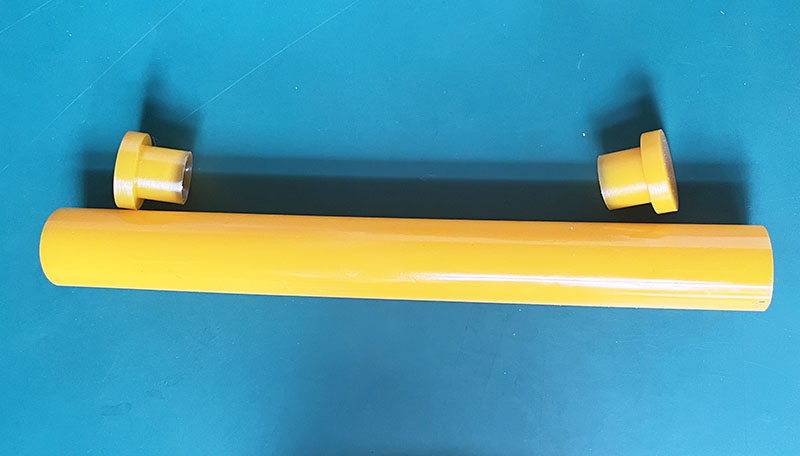

Isostatic Pressing of Cemented Carbide Powder
Cold isostatic pressing dies are widely used in the isostatic pressing of cemented carbide powder. This article will give a detailed introduction to cemented carbide. Cemented carbide has a wide range of applications, including engineering, machinery, automobiles, ships, optoelectronics, military and other fields. The cemented carbide industry consumes more than half of the total tungsten consumption.
1. Definition Cemented carbide (tungsten carbide) is an alloy that uses tungsten carbide powder (WC) as the main production material and cobalt, nickel, molybdenum and other metals as binders. The composition of tungsten carbide with high specific gravity is not much different. . Tungsten alloy is an alloy with tungsten as the hard phase and metal elements such as nickel, iron, and copper as the binder phase.
2. Features
1) High hardness (86-93HRA, equivalent to 69-81HRC). Under other conditions unchanged, the higher the tungsten carbide content, the finer the grain, the greater the hardness of the alloy.
2) Good wear resistance. The tool life of this material is 5-80 times higher than that of high-speed steel cutting; the life of abrasive tools produced by this material is 20-150 times higher than that of steel grinding tools.
3) Excellent heat resistance. Its hardness remains basically unchanged at 500°C, and is still very high at 1000°C.
4) Strong corrosion resistance. Under normal circumstances, it does not react with hydrochloric acid and sulfuric acid.
5) Good toughness. Its toughness is determined by the binder metal, and the higher the binder phase content, the greater the flexural strength.
6) High brittleness. It is difficult to make tools with complex shapes because cutting operations cannot be performed.
It can be used to make drill bits, cutting tools, rock drilling tools, mining tools, wear-resistant parts, cylinder linings, nozzles, motor rotors and stators, etc.
Note: Depending on the application, the particle size of the raw material WC particles is also different. For example, cutting machine blades, V-CUT knives and other finishing tools are suitable for production with ultra-fine, sub-fine, and fine-grained tungsten carbide; rough machining tools are suitable for medium-grained WC as raw materials; gravity cutting tools are suitable for medium- and coarse-grained carbide Tungsten is used for production; mining tools are suitable for coarse-grained WC as raw materials.
Cemented carbide workpieces can be formed by various techniques. Depending on the size of the workpiece, the complexity of the shape and the production volume, most of the cutting inserts are molded with top-pressure and bottom-pressure rigid molds. In each pressing, in order to maintain the consistency of workpiece weight and size, it is necessary to ensure that the amount of powder (mass and volume) flowing into the cavity is exactly the same. The fluidity of the powder is mainly controlled by the size distribution of the agglomerates and the characteristics of the organic binder. By applying a molding pressure of 10-80ksi (thousand pounds per square foot) on the powder loaded into the cavity, a molded workpiece (or "blank") can be formed.
Even under extremely high molding pressure, the hard tungsten carbide particles will not be deformed or broken, while the organic binder is pressed into the gap between the tungsten carbide particles, thereby fixing the position of the particles. The higher the pressure, the tighter the combination of tungsten carbide particles and the greater the compaction density of the workpiece. The molding characteristics of grades of cemented carbide powder may vary, depending on the content of metal binder, the size and shape of tungsten carbide particles, the degree of agglomeration, and the composition and amount of organic binder. In order to provide quantitative information on the compression characteristics of cemented carbide powders, powder manufacturers usually design and build the corresponding relationship between molding density and molding pressure. This information ensures that the supplied powder is in harmony with the tool manufacturer's molding process.
CIP Process for Cemented Carbide Rod Forming
1. Pressure cutting method
The ground and sieved carbide powder is pressed into a block, and then subjected to cold isostatic pressing before subsequent processing. In this process, as long as a small amount of plasticizers, such as paraffin, polyethylene glycol and so on. If the pressure of cold isostatic pressing is high enough (400MPa), no binder can even be added. The bar formed by this method has a very rough surface and must be ground and turned before the finished product.
2. Wet bag method
The mold is evenly pressed in the high-pressure liquid (about 200MPa), and the size of the test piece is limited by the mold cavity, which is not suitable for mass production and is mainly used for large-diameter bars.
3. Dry bag method
It uses different fluids as the pressure transmission medium, the mold is semi-fixed, and the addition and removal of blanks are all operated in a dry state. High degree of automation, short operation cycle, suitable for batch molding. The length of the rod formed by this method is longer than that of the mechanical molding method (up to 400mm), and a small amount (1% to 1.5%) of paraffin or polyvinyl alcohol is used for molding.



We support all kinds of customization, if you need it, please contact us.
Phone/whatsapp:+86 18234744811
Email:sales@highindustryco.com